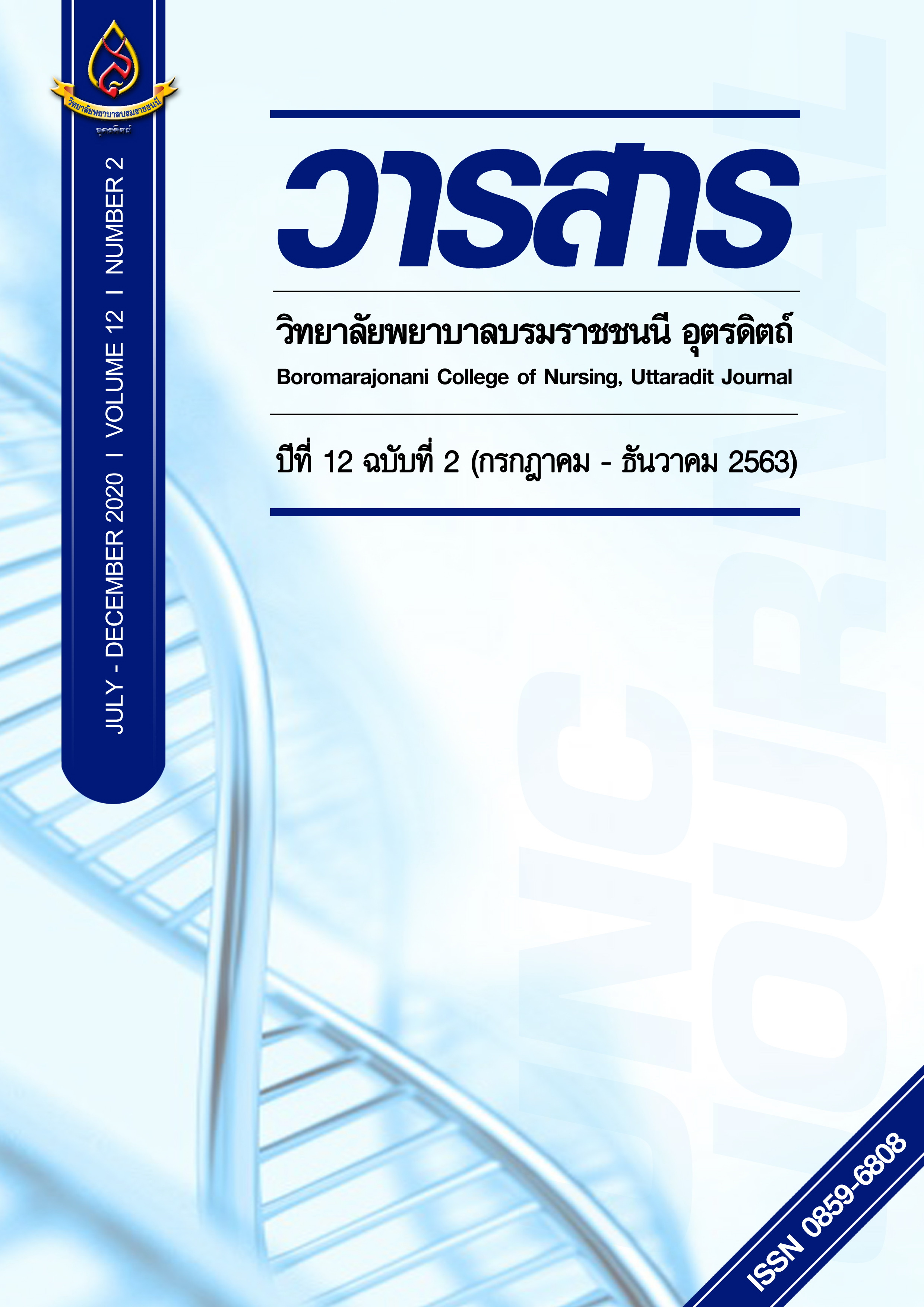การผ่าตัดย้ายเส้นประสาทในกลุ่มผู้ป่วยข่ายประสาทส่วนแขนบาดเจ็บ: การปฏิบัติการพยาบาล
Main Article Content
บทคัดย่อ
การพยาบาลผู้ป่วยที่ได้รับการผ่าตัดถ่ายโอนเส้นประสาทบราเคียล เพล็กซัส เป็นการสนับสนุนการรักษาเพื่อส่งเสริมให้เกิดการฟื้นตัวของเส้นประสาทที่ได้รับการบาดเจ็บ หากได้รับการดูแลที่ไม่มีประสิทธิภาพ จะมีผลกระทบต่อการฝ่อลีบของกล้ามเนื้อเพิ่มขึ้น สูญเสียสมรรถภาพของมือและแขนอย่างถาวร ดังนั้น พยาบาลผู้ให้การดูแลผู้ป่วยจำเป็นต้องมีความรู้ความเข้าใจเกี่ยวกับการบาดเจ็บ มีทักษะในการประเมินการทำหน้าที่ของเส้นประสาท รวมไปถึงการพยาบาลผู้ป่วยในระยะหลังการผ่าตัด ครอบคลุมเทคนิคการจัดท่า การกระตุ้นเส้นประสาท เทคนิคการประคบเย็นร่วมกับการบริหารกล้ามเนื้อเพื่อเพิ่มความทนทานของกล้ามเนื้อส่วนปลายแขน การรับประทานอาหารและเทคนิคการบริหารจัดการกับอารมณ์ความรู้สึกในขณะเจ็บป่วย นอกจากนี้การมีส่วนร่วมของครอบครัวในการดูแลผู้ป่วย ซึ่งสามารถนำไปสู่แนวทางในการป้องกันความล้มเหลวที่อาจจะเกิดขึ้นภายหลังจากการผ่าตัดได้
Article Details
บทความหรือข้อคิดเห็นใดใดที่ปรากฏในวารสารวิจัยการพยาบาลและวิทยาศาสตร์สุขภาพ เป็นวรรณกรรมของผู้เขียน ซึ่งบรรณาธิการหรือสมาคมศิษย์เก่า ไม่จำเป็นต้องเห็นด้วย และบทความที่ได้รับการตีพิมพ์เผยแพร่ถือเป็นลิขสิทธิ์ของวารสารวิจัยการพยาบาลและวิทยาศาสตร์สุขภาพ
เอกสารอ้างอิง
Bryanton, M. A., Chodan, S. D., Vander Meulen, J., Fenrich, K. K., & Misiaszek, J. E. (2019). The effect of light touch on standing sway when the stability of the external touch reference becomes unreliable. Experimental brain research, 237(3), 663-672.
Bulstra, L. F., & Shin, A. Y. (2016). Nerve transfers to restore elbow function. Hand clinics, 32(2), 165-174.
Bundit Klaosuwan. (2001). Effective techniques of physical therapy treatment for brachial plexus injuryed patients: a report of four cases. Journal of medical technology and physical therapy, 13(2), 86-93. (in Thai).
Green, J. A., Hirst-Jones, K. L., Davidson, R. K., Jupp, O., Bao, Y., MacGregor, A. J., ... & Clark, I. M. (2014). The potential for dietary factors to prevent or treat osteoarthritis. Proceedings of the Nutrition Society, 73(2), 278-288.
Haase, J., & Wiedmann, K. P. (2018). The sensory perception item set (SPI): an exploratory effort to develop a holistic scale for sensory marketing. Psychology & Marketing, 35(10), 727-739.
Han, G., & Ceilley, R. (2017). Chronic wound healing: a review of current management and treatments. Advances in therapy, 34(3), 599-610.
Hansen, C., Wayment, B., Klein, S., & Godfrey, B. (2018). Iodine–Starch test for assessment of hyperhidrosis in amputees, evaluation of different methods of application. Disability and rehabilitation, 40(25), 3076-3080.
Kaiser, R., Waldauf, P., Ullas, G., & Krajcová, A. (2018). Epidemiology, etiology, and types of severe adult brachial plexus injuries requiring surgical repair: systematic review and meta-analysis. Neurosurgical review, 1-10.
Landers, Z. A., Jethanandani, R., Lee, S. K., Mancuso, C. A., Seehaus, M., & Wolfe, S. W. (2018). The psychological impact of adult traumatic brachial plexus injury. The Journal of hand surgery, 43(10), 950e-905e6.
Martin, E., Muskens, I. S., Senders, J. T., Cote, D. J., Smith, T. R., & Broekman, M. L. (2019). A nationwide analysis of 30‐day adverse events, unplanned readmission, and length of hospital stay after peripheral nerve surgery in extremities and the brachial plexus. Microsurgery, 39(2), 115-123.
Martinez-Hervás, S., Mendez, M. M., Folgado, J., Tormos, C., Ascaso, P., Peiró, M., ... & Ascaso, J. F. (2017). Altered Semmes–Weinstein monofilament test results are associated with oxidative stress markers in type 2 diabetic subjects. Journal of translational medicine, 15(1), 187.
Phalita, N., Octaviana, F., Sutanto, A., Safri, A. Y., Estiasari, R., Imran, D., & Hakim, M. (2017). Distal symmetric polineuropathy in HIV patients: Sensory nerve conduction study and stimulated skin wrinkle test (case control study). Journal of the Neurological Sciences, 381, 1093.
Rivera, J. C., Glebus, G. P., & Cho, M. S. (2014). Disability following combat-sustained nerve injury of the upper limb. The bone & joint journal, 96(2), 254-258.
Rungtip Chokpraisin. (2011). Effect of electrical stimulation after nerve transfer in brachial plexus injury: a randomized control trial. Journal of Thai rehabilitation medicine, 21(1), 7-12. (in Thai)
Sananpanich, K., & Kraisarin, J. (2015). Descending genicular artery free flaps: Multi-purpose tissue transfers in limb reconstruction. Journal of Plastic, Reconstructive & Aesthetic Surgery, 68(6), 846-852.
Steluti, J., Reginaldo, C., Selhub, J., Paul, L., Fisberg, R. M., & Marchioni, D. M. (2018). Presence of circulating folic acid in plasma and its relation with dietary intake, vitamin B complex concentrations and genetic variants. European journal of nutrition, 1-9.
Thatte, M. R., Babhulkar, S., & Hiremath, A. (2013). Brachial plexus injury in adults: Diagnosis and surgical treatment strategies. Annals of Indian Academy of Neurology, 16(1), 26.
Wendt, M., Novak, C. B., & Anastakis, D. J. (2018). Prevalence of cold sensitivity in upper extremity nerve compression syndromes. Journal of Hand Surgery (European Volume), 43(3), 282-285.
Wojtkiewicz, D. M., Saunders, J., Domeshek, L., Novak, C. B., Kaskutas, V., & Mackinnon, S. E. (2015). Social impact of peripheral nerve injuries. Hand, 10(2), 161-167.
Yang, J., Qin, B., Fu, G., Li, P., Zhu, Q., Liu, X., ... & Gu, L. (2014). Modified pathological classification of brachial plexus root injury and its MR imaging characteristics. Journal of reconstructive microsurgery, 30(03), 171-178.
Zivkovic, M. Z., Djuric, S., Cuk, I., Suzovic, D., & Jaric, S. (2017). A simple method for assessment of muscle force, velocity, and power producing capacities from functional movement tasks. Journal of sports sciences, 35(13), 1287-1293


